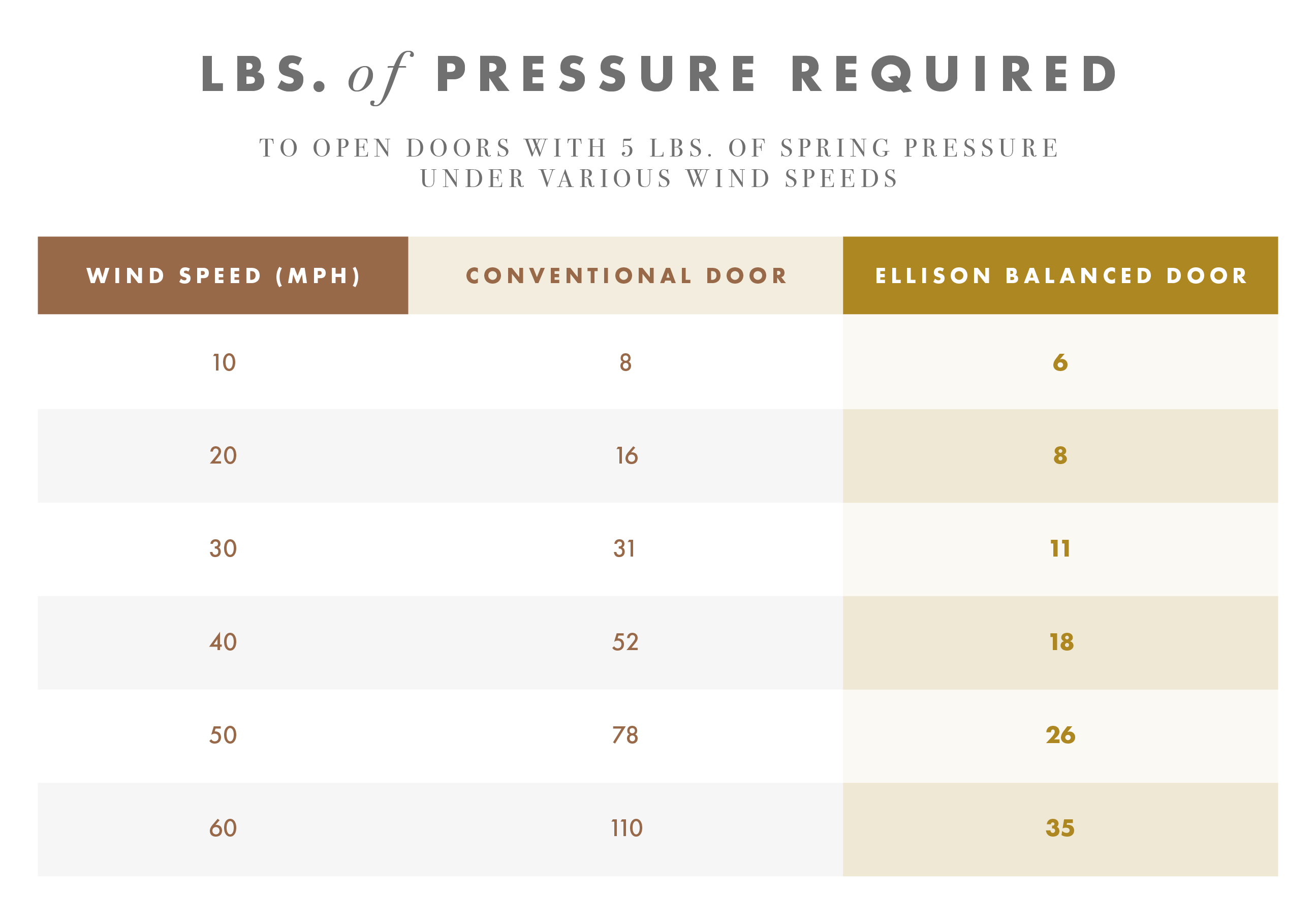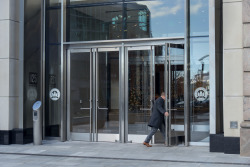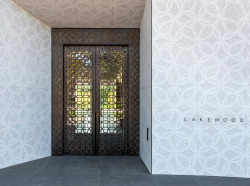How It Works: The Five Things That Set a Balanced Door Apart
Plato famously wrote, “Necessity is the mother of invention.”
This was the case for the invention of the balanced door.
In 1927, Edward Ellison, an imaginative engineer from Jamestown, New York, and his brother Oliver, a skilled tool designer with a profound understanding of metallurgy, recognized a need for a better door design in the commercial building sector. Buildings, especially those in big cities, were being designed taller and more tightly compressed within a city block. Therefore, there was a need for a door that could more easily overcome external wind pressure and internal building stack pressure. At the time, nothing of the sort existed.
Combining their unique skills, the brothers invented the balanced door – an ingenious design that not only solved the pressure issues, but surprised users with how easy it was to open with its effortless operation. Its design also led to reduced door leaf projection onto sidewalks and completely eliminated the lateral stress that traditional swing doors face.
So, what makes a balanced door so special?
Here are the top five things that set a balanced door apart.
#1 – System Design
An Ellison balanced door is more than a door that opens and closes. It is a unique, unified system that is comprised of three important components: the door leaf, frame, and innovative balanced hardware.
The balanced hardware is what truly sets an Ellison door apart. Most doors feature a traditional design that has two or three hinges along the vertical side of the door that attach to the frame. This design creates inevitable lateral stress on the hinges, which can eventually lead to the failure of the entrance system, especially for commercial or multifamily buildings where the doors are opened and closed hundreds or even thousands of times a day.
The balanced hardware distributes the door’s weight much more evenly across the frame. It also relies on a component called the floor box, which is a base plate that is either on or recessed into the ground that accepts the steel pivot shaft assembly. This allows the door’s weight and opening force to be distributed into the ground as opposed to completely on a series of hinges, which are weaker.
#2 – Reduced Opening Force
Operating a conventional door requires pulling against its entire weight because it is attached by hinges on one side only. Instead of pivoting from a single side, balanced doors turn from an inset pivot point located at two-thirds width of the door leaf.
When talking about opening and closing forces of a door, there are three main factors to consider: stack pressures, wind load, and door weight.
Tall buildings tend to build up internal building stack and HVAC pressures that make a door more difficult to close without fluttering. In addition, from the opposite side, outdoor wind loads make a door more difficult to open because of the added force being applied to it.
The balanced door solves this problem by allowing air pressures (both internal and external) to pass on both sides of the door frame. Air passes on the side that the user is opening it, and it also passes through the gap on the opposite side created by the inset pivot point. This results in “the door you can open with one finger.”
In addition, reduced closing force means a user does not have to rush out of the way of a speedily closing door during episodes of heavy wind.
Finally, weight is of course a contributing factor to the opening and closing of a door. Door designs that include heavy components, such as rosettes or grilles, can also add a significant amount of weight to the door leaf. Balanced hardware helps to overcome this.

#3 – Unsurpassed Longevity
Commercial and multifamily entryways must be built with strong, heavy materials such as steel, bronze, extruded aluminum, wood, and glass so that they can withstand constant foot traffic. They must also be strong enough to provide the necessary security for a building.
The inset pivot point such as the one found on balanced doors is of particular importance when those doors are heavy because it allows them to open with ease and reduces stress on the hardware. It also helps that the weight of a balanced door is transferred downward into the floor. As a result, the weight of a door is virtually inconsequential. Therefore, Ellison doors can be built far stronger than traditional swing doors, and can significantly outlast them as well. In fact, some Ellison balanced doors built and installed in the 1930s are still in operation to this day.
#4 – Reduced Leaf Projection
Many major cities have ordinances regarding how far a door can extend into the walking area of a sidewalk. With standard entrance doors, their entire width may extend fully into walking areas, which can be a hindrance for busy city walkways. Alternatively, with balanced doors, the elliptical motion opening path reduces door leaf projection by a third. This frees up valuable space for cities with stringent sidewalk encroachment codes such as New York City.
#5 – Aesthetic Design Options
Performance, longevity, and durability are all critical when designing a successful entrance system, but aesthetics play a key role as well.
Entrance doors are the first part of the building a guest interacts with, so designing them to make a good first impression is important.
Each Ellison custom balanced door is handcrafted to an architect’s exact specification. It is not a cookie-cutter approach where all doors are created to a select few designs on an assembly line. Architects pick from their choice of a number of durable materials including bronze, stainless steel, aluminum, wood, and glass. Ellison doors can be designed to feature decorative grilles or trim for an elegant appearance. They can also be designed to include impressive transoms and sidelights to give the entrance system more visual impact and let natural daylight into a space.
Architects pick the door size as well to fit any architectural specification for an entrance system. In general terms, the maximum width of a balanced door is 48”, and the maximum height is 144”.
The Door That Does It All
Architects and designers searching for a door that meets all the criteria in terms of durability, longevity, performance, and aesthetics need to look no further than the original balanced doors from Ellison Bronze. In fact, Ellison has been entrusted by the most highly regarded architectural firms to create balanced doors for some of the world’s most famous addresses.
Ready to design your own show-stopping custom balanced doors for your next project?
AIA Continuing Education
Receive 1 AIA CES HSW/SD credit hour through our new online course.






